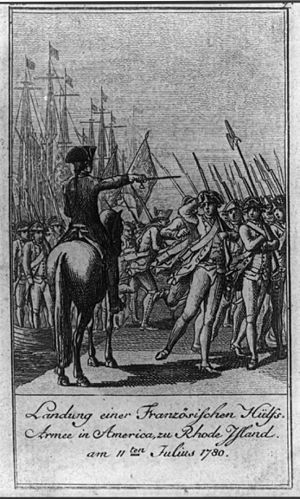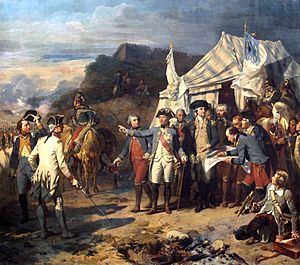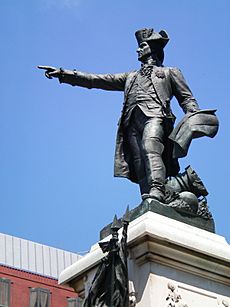Jean-Baptiste Donatien de Vimeur, comte de Rochambeau facts for kids
Quick facts for kids
Jean-Baptiste Donatien de Vimeur de Rochambeau
|
|
|---|---|

Portrait by Charles Wilson Peale, 1782
|
|
| Born | 1 July 1725 Vendôme, Orléanais, France |
| Died | 30 May 1807 (aged 81) Thoré, Loir-et-Cher, France |
| Allegiance | |
| Service/ |
French Army |
| Years of service | 1742–1792 |
| Rank | Marshal of France |
| Battles/wars | War of the Austrian Succession
|
| Awards | Society of the Cincinnati |
| Signature | |
Jean-Baptiste Donatien de Vimeur, comte de Rochambeau (born July 1, 1725 – died May 10, 1807) was a French nobleman and a very important general. His army played a key role in helping the United States win its independence from the British. This happened at the Battle of Yorktown in 1781 during the American Revolutionary War.
Rochambeau was the commander-in-chief of the French Expeditionary Force. This was a special army sent by France to help the American Continental Army fight against British forces.
Contents
Early Military Career
Jean-Baptiste Donatien de Vimeur was born in Vendôme, France. He went to a Jesuit college in Blois for his education. After his older brother passed away, he joined a cavalry regiment.
He fought in several wars across Europe, including the War of the Austrian Succession. By 1747, he had become a colonel. He also took part in the Siege of Maastricht (1748). In 1749, he became the governor of Vendôme.
During the Seven Years' War, he showed great bravery in the Battle of Minorca (1756). Because of his courage, he was promoted to Brigadier General. He continued to fight in Germany, where he was wounded several times.
Helping America Win Freedom
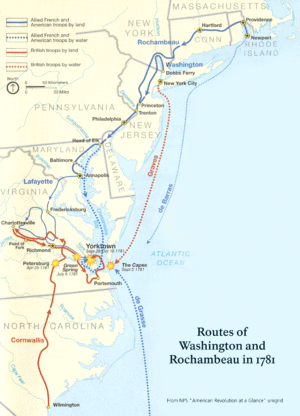
In 1780, Rochambeau was chosen to lead about 7,000 French troops. This force was sent to America to help George Washington and the Continental Army. He was given the rank of Lieutenant General.
He arrived in Newport, Rhode Island, on July 10, 1780. His troops stayed there for a year. This was because the British navy had blocked the French fleet in Narragansett Bay.
Some of Rochambeau's troops even camped at what is now Brown University. The main building there, University Hall, was used as a military hospital.
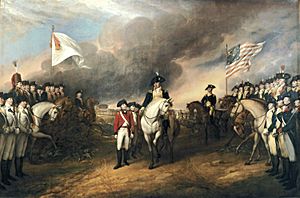
In July 1781, Rochambeau's army left Rhode Island. They marched across Connecticut to meet General Washington's forces. They met near the Hudson River in Mount Kisco, New York. Rochambeau used the Odell House as his headquarters for over a month.
Washington and Rochambeau then joined their armies. They marched together along the Washington–Rochambeau Revolutionary Route. Their goal was to trap the British army at Yorktown.
They also worked with the French navy in the Battle of the Chesapeake. This battle prevented the British navy from helping their army. On September 22, the combined forces met with Marquis de Lafayette's troops.
They surrounded the British army, led by Lord Cornwallis. Cornwallis's army was greatly outnumbered and trapped. On October 19, he was forced to surrender. This victory was a huge turning point in the American Revolutionary War.
The American Congress gave Rochambeau two cannons taken from the British. He later returned them to his hometown in France. Rochambeau was also a member of the Society of the Cincinnati. This was a group for officers who fought in the American Revolution.
Life After the Revolution
When Rochambeau returned to France, King Louis XVI honored him. He was made governor of the province of Picardy.
Rochambeau supported the French Revolution that began in 1789. On December 28, 1791, he became one of the last two generals to be named Marshal of France by King Louis XVI. This was a very high military rank.
When the French Revolutionary Wars started, he commanded the Armée du Nord for a short time in 1792. However, he resigned after some defeats against the Austrians.
During a dangerous period called the Reign of Terror (1793–94), he was arrested. He was very lucky to avoid being executed. Later, Napoleon gave him a pension. Rochambeau passed away in 1807 at Thoré-la-Rochette.
Rochambeau's Legacy
Honoring a Hero

Many places and things are named after Rochambeau to honor his contributions.
- In 1902, President Theodore Roosevelt unveiled a statue of Rochambeau in Lafayette Square, Washington, D.C.. This statue was a gift from France to the United States.
- The French Navy named an ironclad ship Rochambeau after him.
- A transport ship used by the United States Navy during World War II was named USS Rochambeau.
- In 2009, the Washington–Rochambeau Revolutionary Route was named a National Historic Trail.
- A bridge connecting Washington D.C. with Virginia, part of the 14th Street Bridge (Potomac River) complex, is named for Rochambeau.
- Brown University has a building called Rochambeau House, which houses its French Department.
- In 1934, a replica of a statue of General Rochambeau from Paris was donated to Newport, Rhode Island.
His Writings
Rochambeau's own military memoirs were published in 1809. Part of his writings about the American War of Independence were translated into English in 1838. His letters from the American campaign were also published later.
Other Tributes
- Rochambeau's son, Donatien-Marie-Joseph de Vimeur, vicomte de Rochambeau, was also an important military figure.
- Rochambeau Middle School in Southbury, Connecticut, is named after him.
- The Rochambeau Bridge carries Interstate 84 between Southbury and Newtown, Connecticut. Rochambeau's army marched through this area.
- Many streets and shopping centers in Connecticut are named in his honor.
- The French international school in Bethesda, Maryland, is called Lycée Rochambeau.
- There are Rochambeau Drives in Greenburgh, New York, and Williamsburg, Virginia.
- There are Rochambeau Avenues in Providence, Rhode Island, New Bedford, and the Bronx, New York.
- A Rochambeau Playground is located in San Francisco, California.
- A Rochambeau Farm is on Historic Guard Hill in Bedford Corners, New York.
- There is a monument to Rochambeau at French Hill in Marion, Connecticut.
- Rochambeau is mentioned twice in the popular American musical Hamilton. In the songs "Guns and Ships" and "Yorktown (The World Turned Upside Down)", his name is used as a code word, showing his importance in the war.
Motto and coat of arms
| Coat of arms | Motto |
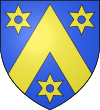 |
See also
 In Spanish: Jean-Baptiste Donatien de Vimeur de Rochambeau para niños
In Spanish: Jean-Baptiste Donatien de Vimeur de Rochambeau para niños


